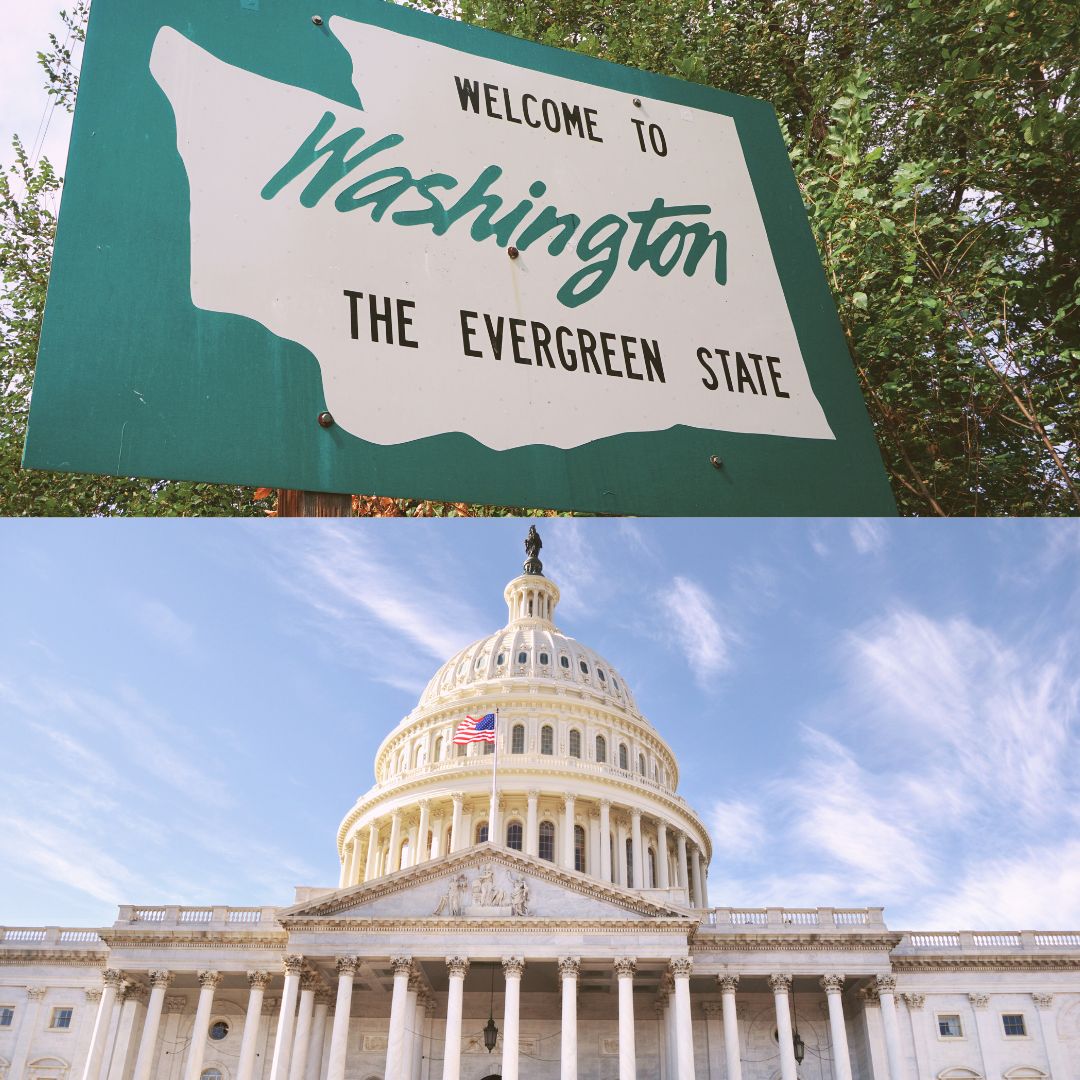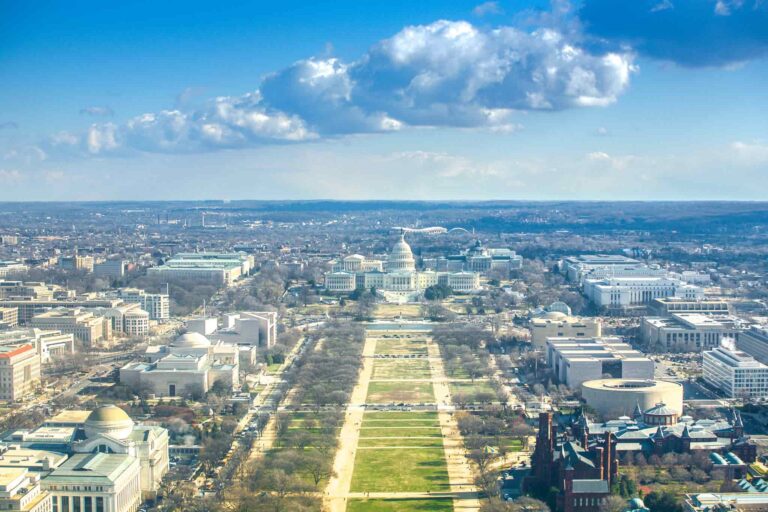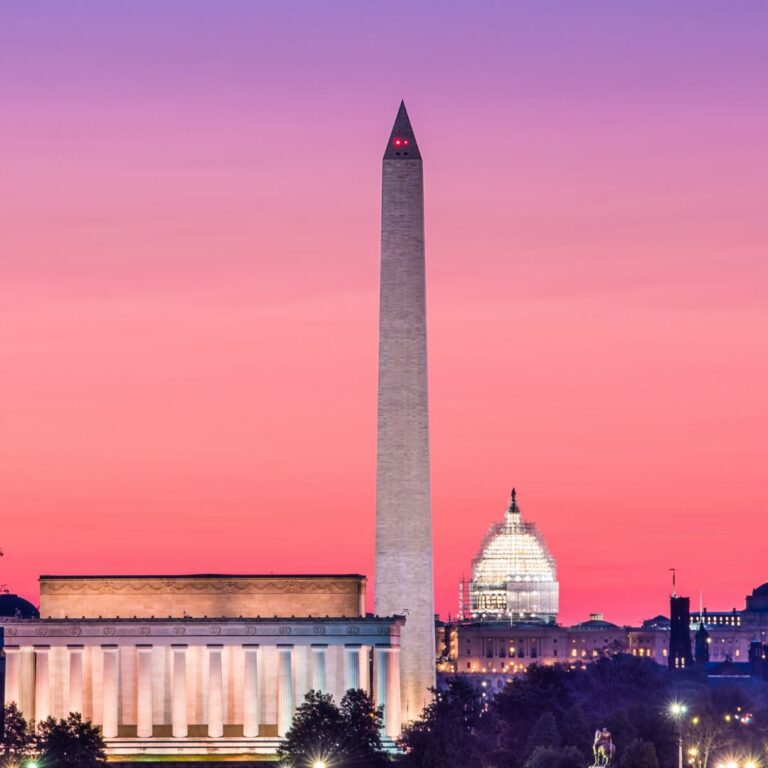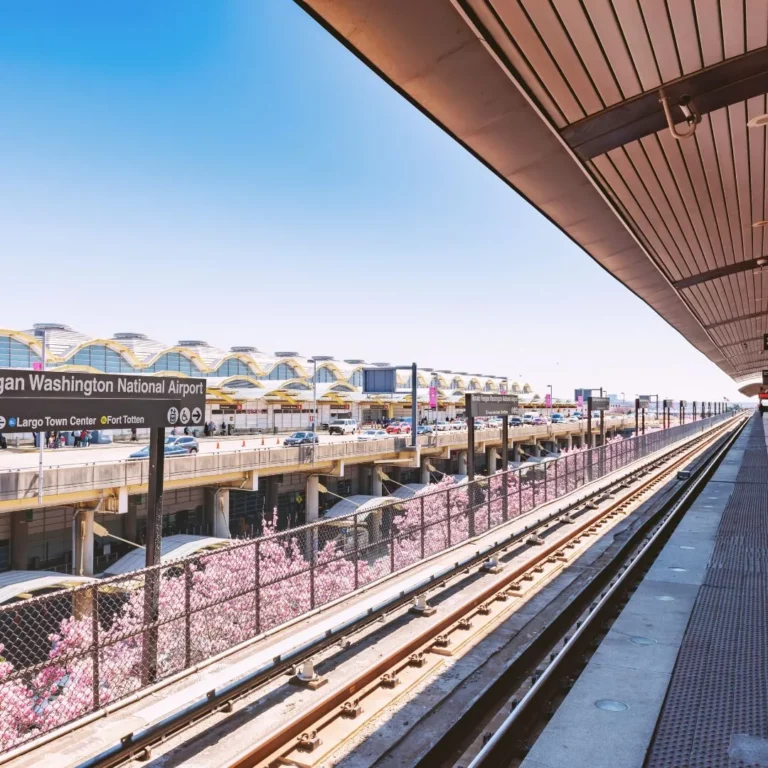Washington State and Washington D.C. are two distinct areas in the United States that often cause confusion due to their similar names. Here are the differences to be aware of if you are planning travel to either one.
Washington VS Washington DC: Location
The key difference between these two locations lies in their geographical positions. Washington State, also known as the Evergreen State, is locate on the West Coast of the United States. Its diverse terrain includes coastal regions, mountain ranges, and forests.

On the other hand, Washington D.C., also known as the District of Columbia, is located on the East Coast. It serves as the nation’s capital city. It is a federal district and not a state, which differentiates itself through its governance, as it does not have the usual state institutions like a state constitution, governor, or bicameral legislature.
It houses the White House, Capitol building, and the Supreme Court, making it the center of the nation’s political operations. These differences in geography, governance, and purpose clearly distinguish Washington State from Washington D.C., providing unique characteristics and contributions to the country.
Washington Vs Washington DC: Airports
If you are traveling to Washington DC, you will use one of the following airports:
- DCA: Also known as Ronald Regan Airport, this is just outside the city in the nearby town of Arlington, Virginia.
- IAD: This is the major international airport in the area. It is also called Dulles International and it is about 30 to 40 minutes from Washington DC.
- BWI: This airport is closer to the city of Baltimore which is about 45 minutes north of Washington DC.
If you are traveling to Washington State, you will use one of the following airports:
- SEA: This is Seattle-Tacoma airport and it is the largest and busiest airport in this state.
- GEG: Spokane International Airport is the primary airport serving the Spokane area and is the second largest in Washington State. It is close to the border of the state of Idaho.
City Vs State
Another main difference is that Washington DC is a metropolitan city. It is located a 4 hour drive from New York City.
Washington State is a large state (similar to a province) with many cities in it. The major city here is Seattle.
Washington State has an area of 71,298 square miles, making it the 18th largest state in the US. In contrast, Washington DC covers just 68.34 square miles and is not part of any state.
Geography
Washington state is located in the Pacific Northwest region of the United States, bordered by Canada to the north and Oregon to the south. It lies along the Pacific Ocean coast and covers a diverse landscape, including the Olympic Peninsula, the Cascade Range, and the Columbia Plateau. Notably, it falls within the Western time zone.
In contrast, Washington DC is a federal district located on the East Coast, flanked by Maryland and Virginia. While it is not part of any specific state, it is often considered part of the southern states of the US. Washington DC spans over a considerably smaller area compared to Washington state.
Bodies Of Water
In Washington state, a significant body of water is the Puget Sound, an inlet of the Pacific Ocean that stretches along the western coast. This coastal region is characterized by its lush green forests, mountains, and an abundance of marine life.
Washington DC, on the other hand, is between the Potomac and Anacostia Rivers. The Potomac River serves as a major waterway and natural border between Washington DC and Virginia, while the Anacostia River flows through the eastern part of the city, offering recreational opportunities and supporting diverse ecosystems.
History And Origin
The history of both Washington state and Washington, D.C., can be traced back to different periods in American history. Washington, D.C., is a federal district established in 1790 under the Residence Act, which was passed during the tenure of the first president of the United States, George Washington. The aim was to create a neutral territory to serve as the nation’s capital. The need for this arose from discussions between important figures like James Madison, Thomas Jefferson, and President George Washington himself. The land for the creation of the district was donated by Maryland and Virginia.
On the other hand, Washington state is located in the Pacific Northwest region of the United States. It became the 42nd state admitted to the Union on November 11, 1889. Contrary to the District of Columbia, Washington state, with its rich natural resources and vast territory, is the 18th largest state in the United States.
Statehood And Development
Throughout their history, both Washington, D.C., and Washington state have undergone significant transformations. The District of Columbia has evolved over time, weathering numerous challenges, including the burning of the White House during the War of 1812 or the riots and protests of the 1960s. However, through perseverance and commitment, the district has emerged to become a symbol of power and democracy known worldwide as the capital of the United States of America.
The growth of Washington state can be credited to its natural resources, such as timber and farming, along with its development as a trade and transportation hub. Seattle, the largest city in the state, has evolved into a major center for technology and innovation, attracting companies like Microsoft and Amazon. The state’s diverse population and progressive policies have been fundamental in the development of Washington as a significant player in American history.
Washington DC Vs Washington State: Government And Economy
Federal Government
Washington, DC, also known as the District of Columbia, serves as the seat of the government of the United States. It is home to the White House, the residence of the U.S. president, the Supreme Court, and Capitol Hill, where the U.S. Congress convenes. As a federal district, Washington, DC, is under the direct jurisdiction of the federal government. This unique status has implications for its representation in the U.S. Congress. In contrast, Washington state is a separate entity located in the Pacific Northwest, with its own state government and representation in Congress.
Through the 23rd Amendment to the U.S. Constitution, residents of Washington, DC, are granted the right to vote in presidential elections, but they do not have full voting rights in Congress. DC’s representative in the House of Representatives is a non-voting delegate who can participate in debates and vote in committees but cannot cast a deciding vote on the House floor.
On the other hand, Washington state has two senators and ten representatives with full voting rights in the U.S. Congress. These elected officials can vote on all matters in both chambers of Congress, representing their constituents’ interests at the federal level.
Local Governance
The governance structures of Washington, DC, and Washington state are quite different. As a state, Washington has its own governor, state legislature, and local city councils. The state government has the authority to create and execute laws within its borders, and its residents are represented at the local, state, and federal levels.
In contrast, Washington, DC, despite having its own mayor and city council, does not enjoy the same level of autonomy as a state. The federal government has the ability to override legislation passed by the D.C. city council, and much of its budget is subject to approval by the U.S. Congress. This limited autonomy has prompted calls for Washington, DC, to be granted statehood, which would provide its residents with full representation in Congress and more control over their local government. However, achieving statehood would likely require a constitutional amendment, making it a challenging and contentious political issue.
Economy And Industry
The economy of Washington State benefits from a diverse range of industries, such as technology, aerospace, agriculture, and tourism. In contrast, the economy of Washington D.C. is largely driven by government-related jobs and industries, such as consulting, law, and lobbying. This distinction has led to a more balanced economic growth in Washington State, while Washington D.C.’s economy is heavily influenced by the federal government’s activities and policies.
In Washington State, some prominent sectors include:
- Agriculture: The state is a leading producer of red raspberries, with over 90% of the U.S. production. It is also a major producer of spearmint oil, which is used in the flavorings industry.
- Technology: The state is known for its thriving technology sector, hosting global giants like Microsoft and Amazon, as well as numerous startups and innovation hubs.
- Aerospace: Washington State is recognized for its aerospace industry, with Boeing being a key player in the area.
Washington D.C., on the other hand, is characterized by:
- Government-related jobs: The city houses several government agencies, making it a prime location for professionals in law, consulting, and lobbying fields.
- International organizations: The presence of foreign embassies and international organizations, such as the World Bank and the International Monetary Fund, contributes significantly to the local economy.
Difference Between Washington And Washington DC: Summary
One common misconception is that Washington and Washington DC are the same place. To clarify, Washington refers to a state on the western coast of the United States, while Washington DC is the capital city of the USA, situated on the eastern coast1. The abbreviation “DC” in Washington DC stands for the District of Columbia.
Both Washington State and Washington DC experience distinct seasons throughout the year. However, their geographical locations lead to differences in climate and weather patterns. Washington State tends to have a milder climate, with the western region experiencing a temperate maritime climate, while the eastern region has a drier semi-arid climate.
Washington DC, on the other hand, experiences a humid subtropical climate with hot summers, cold winters, and a significant amount of precipitation throughout the year6.







